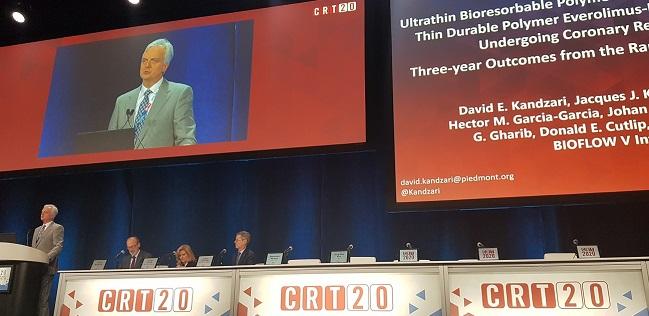BIOFLOW V: Orsiro Bests Xience at 3 Years for TLF, Late Stent Thrombosis
The bioresorbable-polymer, ultrathin-strut design may help DES break through their current safety and efficacy plateau.

NATIONAL HARBOR, MD—At 3 years, the bioresorbable-polymer Orsiro stent maintains an advantage over the durable-polymer Xience, according to new data from the BIOFLOW V study. Compared with PCI patients who received the industry standard, those who received Orsiro had a 40% relative reduction in target lesion failure as well as significantly lower rates of target-vessel MI, ischemia-driven target lesion revascularization, and late/very late stent thrombosis.
“Altogether, these results both advance a new standard for comparison of drug-eluting stents, but they also direct our attention to strut thickness and perhaps polymer composition as key attributes for iterative drug-eluting stent development,” said David Kandzari, MD (Piedmont Heart Institute, Atlanta, GA), who presented the findings here at CRT 2020 on Sunday. The 3-year results were simultaneously published online ahead of print in JACC: Cardiovascular Interventions.
In a press conference prior to his presentation, Kandzari highlighted a “persistent divergence in the event rates between 1 year, 2 years, and 3 years with regard to the absolute difference in TLF.”
The press conference co-moderator William Weintraub, MD (MedStar Washington Hospital Center, Washington, DC), asked whether it was the strut thickness, the polymer, or something else that might be responsible for the good results.
“It’s perhaps in some ways an oversimplification for us to assign one attribute of the stent design to the benefits that we see,” Kandzari responded. “I only say that in part because the bioresorbable polymer of this specific drug-eluting stent does not fully degrade until roughly within a 2-year period. We've already observed at 1 year significantly lower target vessel-related myocardial infarction. But then on the other hand, as the absorption of the polymer goes on, we then see this significant difference in late target lesion revascularization. So, at different time periods, different outcomes begin to emerge between this and the Xience stent.”
A Win for Ultrathin
For the international BIOFLOW V trial, 1,334 patients were randomized 2:1 to the ultrathin-strut (60-μm), bioresorbable-polymer, sirolimus-eluting Orsiro DES (Biotronik) or the thin-strut (81-μm), durable-polymer, everolimus-eluting Xience (Abbott Vascular).
As previously reported, in the first 2 years, the Orsiro stent had better rates of TLF (a composite of cardiovascular death, target vessel-related MI, and clinically driven TLR) compared with Xience, as well as lower rates of the individual endpoints of target vessel-related MI and clinically driven TLR. Orsiro received US Food and Drug Administration approval in February 2019 based on these results.
The new Kaplan-Meier analysis at 3 years shows a TLF rate of 8.2% in the Orsiro group and 13.6% in the Xience group (log-rank P = 0.002). The difference was driven by significantly lower rates of target-vessel MI (5.0% vs 9.2%; log-rank P = 0.003) and clinically driven TLR (3.2% vs 6.7%; log-rank P = 0.006) favoring Orsiro. Kandzari noted in his presentation that the target-vessel MI rates in the Orsiro group were driven both by less early periprocedural MI and less late spontaneous MI, while the clinically driven TLR advantage was driven by fewer late (> 1 year) occurrences compared with Xience.
In a landmark analysis between 30 days and 3 years, divergence in the event rates of target vessel-related MI were nearly threefold higher with Xience than Orsiro (2.8% vs 0.95%; P = 0.01). Similar results were seen in a landmark analysis for ischemia-driven TLR between 30 days and 3 years, with a rate of 4.7% for Xience and 1.5% for Orsiro (P < 0.001).
Additionally, the rates of ARC-defined definite/probable, late/very late stent thrombosis were significantly lower in the Orsiro group compared with Xience (0.1% vs 1.2%; P = 0.018). The incidence of cardiac death or any MI also was lower for Orsiro versus Xience (7.7% vs 11.7%; log-rank P = 0.017).
Breaching the DES Ceiling
Asked by TCTMD why a clinician might choose the Orsiro over the Xience, Kandzari said it is obvious that in the current era of interventional cardiology there is a class effect of DES that has allowed for a plateau in their performance with regard to safety and efficacy.
“These data highlight that indeed that ceiling can be breached, that there is an opportunity to demonstrate superiority even [over] what has historically been considered the gold-standard stent design as a comparator in clinical trials,” he observed. Although longer-term follow-up is needed, Kandzari said the BIOFLOW V results demonstrate the potential to improve upon the current annualized 1.5% to 2% rate of TLR associated with current-generation DES.
“Yes, I believe there are many reasons to think that an ultrathin strut design would have very favorable safety and efficacy in high-bleeding-risk patients, and such a trial by the sponsor is under current planning,” Kandzari said.
L.A. McKeown is a Senior Medical Journalist for TCTMD, the Section Editor of CV Team Forum, and Senior Medical…
Read Full BioSources
Kandzari DE, Koolen JJ, Doros G, et al. Ultrathin bioresorbable polymer sirolimus-eluting stents versus thin durable polymer everolimus-eluting stents for coronary revascularization: three-year outcomes from the randomized BIOFLOW V trial. J Am Coll Cardiol Intv. 2020;Epub ahead of print.
Disclosures
- The study was funded by Biotronik.
- Kandzari reports institutional research/grant support from Biotronik, Boston Scientific, Medinol, Medtronic, OrbusNeich, and Teleflex; and personal consulting honoraria from Biotronik, Cardiovascular Systems Inc, and Medtronic.


Comments